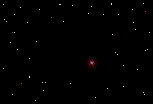


  |
| |
|
Discovered by Pierre Méchain in 1781. Messier 99 (M99, NGC 4254) is one of the fainter Messier objects, and a beautiful spiral galaxy seen almost face-on. Situated in the southern part of constellation Coma Berenices, it is one of the brighter spiral members of the Virgo Cluster of Galaxies. M99 was discovered on March 15, 1781 by Messier's colleague and friend, Pierre Méchain, together with the nearby situated M98 and M100. Charles Messier measured its position and included it in his catalog on April 13, 1781, immediately before finishing the third, final published edition. M99, although situated in constellation Coma Berenices, is one of the bright spiral members of the Virgo Cluster of galaxies. It is of type Sc, rotates clockwise (unlike the nearby spiral M100), and is unusually asymmetric, the nucleus shifted to the upper end of our picture. The present author speculates that this asymmetry could be due to semi-recent encounters with other members of the Virgo Cluster, a hypothesis which may get seconded by the fact that its recession velocity is quite high for a Virgo Cluster member: 2324 km/sec according to the Sky Catalog 2000.0, the highest recession velocity measured for a Messier galaxy (and thus a Messier object at all). This means that it is moving through the Virgo Cluster with a high proper (or peculiar) velocity of at least about 1200 km/sec, by chance in a direction pointing away from us. Taking into account that the relatively nearby (in the sky) galaxy M98 is approaching us at 125 km/sec, and thus moving at about the same peculiar velocity but, by chance, toward us, one may speculate that these two galaxies might have been involved in an encounter, but this is currently not much more than wild speculation. Four supernovae have been recorded in M99: the type II supernova 1967H, mag 14, in June 1967. type II supernova 1972Q, mag 15.6, on Dec 16, 1972, 1986I of type I, mag 14, on May 17, 1986, and supernova 2014L, of type Ic, discovered January 26, 2014 at mag 15.4. M99 was the second nebula, or galaxy, to be recognized as a spiral, by Lord Rosse in spring 1846, about one year after his first discovery of a spiral, M51, in spring 1845. (Credits to SEDS - Students for the Exploration and Development of Space)
| ||
M99 Observer´s Log Spiral Galaxy |
| ||||
This site was last updated 2019-02-10 Site created and maintained by Jorge Lázaro |